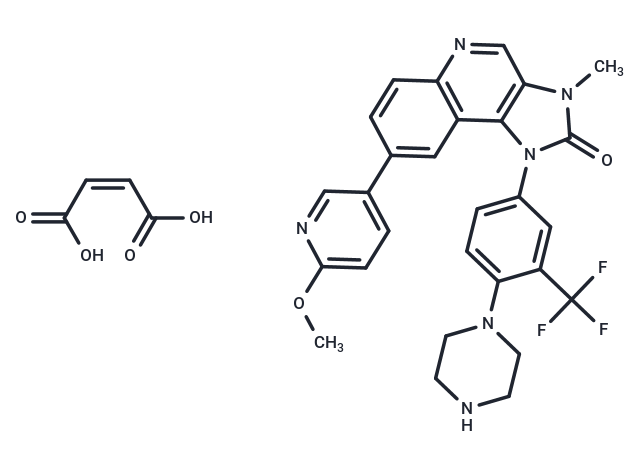Shopping Cart
Remove All Your shopping cart is currently empty
Your shopping cart is currently empty
BGT226 maleate (NVP-BGT226) is a class I PI3K/mTOR inhibitor for PI3Kα/β/γ (IC50: 4/63/38 nM) .

| Pack Size | Price | USA Warehouse | Global Warehouse | Quantity |
|---|---|---|---|---|
| 1 mg | $32 | In Stock | In Stock | |
| 5 mg | $70 | In Stock | In Stock | |
| 10 mg | $116 | In Stock | In Stock | |
| 25 mg | $256 | In Stock | In Stock | |
| 50 mg | $377 | - | In Stock | |
| 100 mg | $539 | - | In Stock | |
| 200 mg | $738 | - | In Stock | |
| 1 mL x 10 mM (in DMSO) | $101 | In Stock | In Stock |
| Description | BGT226 maleate (NVP-BGT226) is a class I PI3K/mTOR inhibitor for PI3Kα/β/γ (IC50: 4/63/38 nM) . |
| Targets&IC50 | PI3Kγ:38 nM, PI3Kβ:63 nM, PI3Kα:4 nM |
| In vitro | The anti-proliferative and pro-apoptotic effects of NVP-BGT226 are independent of bcr-abl status. The activation of the AKT/mTOR signal cascade is suppressed by NVP-BGT226 in a concentration- and time-dependent manner. Flow cytometric analysis exhibits an accumulation of cells in the G(0)-G(1) phase with concomitant loss in the S-phase. NVP-BGT226 displays potent growth-inhibitory activity against all tested cell lines including SCC4, TU183 and KB cell lines with the IC50 ranging from 7.4 to 30.1 nM. Notably, both Detroit 562 and HONE-1 cells, which express PIK3CA mutation H1047R, are still sensitive to the growth-inhibitory effect of NVP-BGT226 treatment. In addition, the sensitivity to NVP-BGT226 between HONE-1 cells and its cisplatin-resistant variant is almost identical. Results of the terminal deoxynucleotidyl transferase-mediated dUTP nick end labeling (TUNEL) assay and the analysis of caspase 3/7 and PARP indicates that NVP-BGT226 induces cancer cell death through an apoptosis-independent pathway. NVP-BGT226 induces autophagy as indicated by the aggregation and upregulation of the microtubule-associated protein light chain 3B-II, and p62 degradation. Gene silencing of Beclin1 or cotreatment of the autophagosome inhibitor, 3-methyladenine, inhibits the NVP-BGT226-induced autophagy and leads to the retrieval of colony survival.[2] NVP-BGT226 inhibits growth in common myeloma cell lines and primary myeloma cells (such as NCI-H929, U266, RPMI-8226 and OPM2 MM cell lines) at nanomolar concentrations in a time-dependent and dose-dependent manner. NVP-BGT226 inhibits phosphorylation of protein kinase B (Akt), P70S6k and 4E-BP-1 in a time-dependent and dose-dependent manner. |
| In vivo | In a xenografted animal model, NVP-BGT226 significantly delays tumor growth in a dose-dependent manner, along with suppressed cytoplasmic expression of p-p70 S6 kinase and the presence of autophagosome formation. NVP-BGT226 inhibits tumor growth in a dose-dependent manner in a FaDu cell xenografted mouse model. Oral administration of NVP-BGT226 at 2.5 and 5 mg/kg for 3 weeks causes 34.7% and 76.1% reduction of the tumor growth on day 21, respectively (compared with control). NVP-BGT226 displays comparable inhibition against tumor growth to rapamycin. The final volume of both groups is significantly smaller than those treated with LY294002 (a PI3K inhibitor) or the control. [2] |
| Cell Research | NCI-H929, U266, RPMI-8226 and OPM2 MM cells are seeded in 96-well plates at a concentration of 1.5 × 104 cells/well in RPMI medium supplemented with 10% fetal bovine serum with or without NVP-BGT226 that is to be tested. After 36 hours, BrdU-labelling solution is added (final concentration: 10 μM), and cells are cultured for another 12 hours in a humidified atmosphere (37 °C/5% CO2). Then, the plates are centrifuged (10 min, 300 g), and the supernatants are discarded. The plates are dried at 60 °C for 2 hours. After fixation with ethanol/HCl for 30 min at -20 °C, the DNA is partially digested by nuclease treatment for 30 min at 37 °C. The cells are washed three times with medium and incubated with anti-BrdU-POD labelling solution for 30 min at 37 °C. The anti-POD solution is removed and the cells are washed three times with washing buffer. The ABTS substrate solution is added, and absorbance is measured in a microplate reader at 405 nm with a reference wave length of 490 nm.(Only for Reference) |
| Synonyms | NVP-BGT226 (maleate), NVP-BGT226, BGT226 |
| Molecular Weight | 650.6 |
| Formula | C28H25F3N6O2·C4H4O4 |
| Cas No. | 1245537-68-1 |
| Smiles | OC(=O)\C=C/C(O)=O.COc1ccc(cn1)-c1ccc2ncc3n(C)c(=O)n(-c4ccc(N5CCNCC5)c(c4)C(F)(F)F)c3c2c1 |
| Relative Density. | no data available |
| Storage | Powder: -20°C for 3 years | In solvent: -80°C for 1 year | Shipping with blue ice/Shipping at ambient temperature. | ||||||||||||||||||||||||||||||
| Solubility Information | Ethanol: < 1 mg/mL (insoluble or slightly soluble) DMSO: 60 mg/mL (92.22 mM), Sonication is recommended. H2O: < 1 mg/mL (insoluble or slightly soluble) | ||||||||||||||||||||||||||||||
| In Vivo Formulation | 10% DMSO+40% PEG300+5% Tween 80+45% Saline: 2 mg/mL (3.07 mM), Sonication is recommended. Please add the solvents sequentially, clarifying the solution as much as possible before adding the next one. Dissolve by heating and/or sonication if necessary. Working solution is recommended to be prepared and used immediately. The formulation provided above is for reference purposes only. In vivo formulations may vary and should be modified based on specific experimental conditions. | ||||||||||||||||||||||||||||||
Solution Preparation Table | |||||||||||||||||||||||||||||||
DMSO
| |||||||||||||||||||||||||||||||
| Size | Quantity | Unit Price | Amount | Operation |
|---|

Copyright © 2015-2025 TargetMol Chemicals Inc. All Rights Reserved.